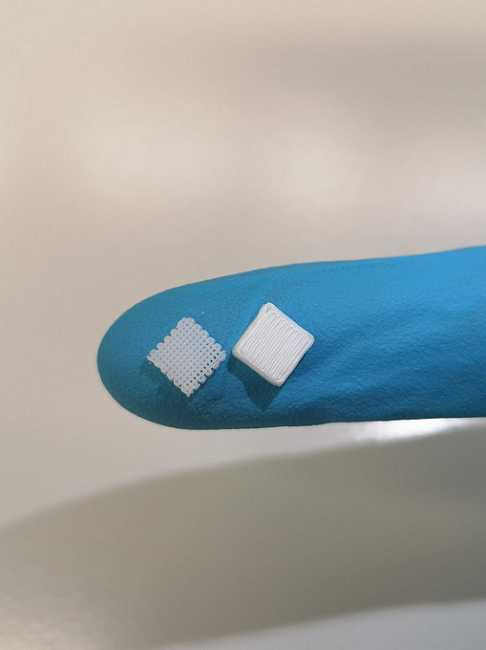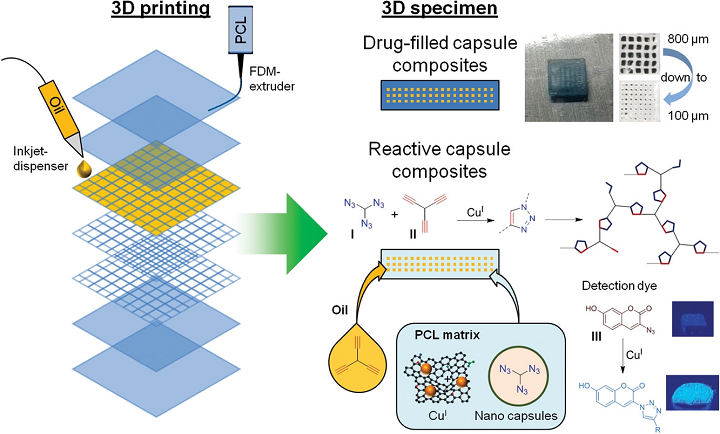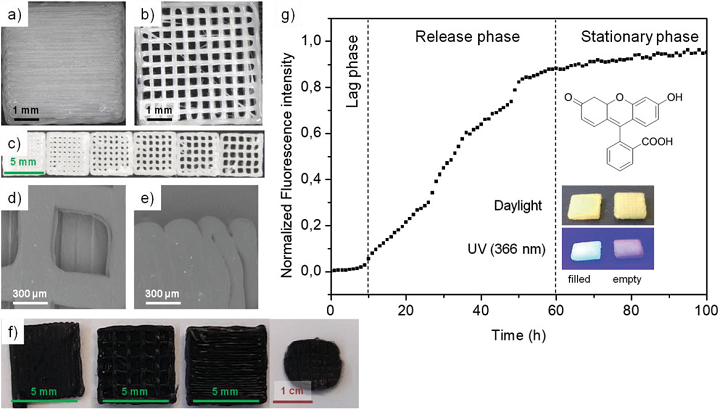If you thought 3D printing with hard materials, like plastic, could be hard, wait until you’ve tried 3D printing with liquids, which sounds like it’s even more difficult. A pair of chemists from Martin Luther University Halle-Wittenberg (MLU) in Germany, Harald Rupp and Wolfgang H. Binder, worked together to create a new combined 3D printing process, where liquids are integrated directly into the materials while printing. With support from the EU’s Horizon 2020 program, the German Research Foundation (DFG), and the Leistungszentrum “System- und Biotechnologie,” Rupp and Binder published a study, titled “3D Printing of Core–Shell Capsule Composites for Post‐Reactive and Damage Sensing Applications,” in Advanced Materials Technologies.
Most of the time, we see that when liquid components are part of a finished 3D printed product, they’re added in later, which is expensive and takes a lot of time. But the two chemists combined the more common method of FDM 3D printing with the process typically used in inkjet printing to integrate liquid into the materials. This could be very useful for multiple applications, such as incorporating active medical agents that can be slowly broken down by the body into pharmaceutical products to prevent post-op inflammation, or integrating luminous liquids for damage monitoring in materials.
 L-R: Inside the 3D printed material, a lattice structure contains the added liquids. Image courtesy of Harald Rupp, MLU
L-R: Inside the 3D printed material, a lattice structure contains the added liquids. Image courtesy of Harald Rupp, MLU“The future lies in more complex methods that combine several production steps. That is why we were looking for a way to integrate liquids directly into the material during the printing process,” explained Professor Binder from MLU’s Institute of Chemistry.
According to the study, 3D printing multicomponent materials instead of using traditional mold casting techniques can be “advantageous.” The chemists used a two printhead system—an FDM modeling extruder and a liquid inkjet head—to add liquids drop by drop during extrusion at the chosen location. This makes it possible to directly integrate the liquid into the first material “in a targeted manner,” and the two researchers were able to print tiny core-shell capsules in 100 to 800 µm sizes.
“This paper reports on a novel method to 3D‐print micro‐sized capsules into a thermoplastic polymer matrix, by combining different 3D printing techniques and composite printing. The approach aims to generate highly functional composite materials based on multi‐compartment structures, mixing a biodegradable polymer (PCL) with nanocapsules and micro scaled fillers, while creating micro‐sized capsules during printing and filling them with hydrophobic liquids,” they wrote. “Void spaces generated during the FDM‐process were filled with liquids using a separate liquid dispenser, placed within the same 3D printing system. Based on this method, 3D printing of a known capsule‐based self‐healing composite, superior over the previous conventional mold casting method, could be realized.[17] The special challenge in using the 3D printing system was the use of two reactive components both embedded into a thermoplastic polymer containing a solid catalyst, which in turn can lead to an externally triggered crosslinking chemistry to enable the design of self‐healing materials. In contrast to conventional encapsulation methods, such as in‐situ polymerization,[18] interfacial polymerization,[19] sol‐gel methods,[20] or solvent‐evaporation emulsion,[21] we here use the 3D printing directly to dispense the liquid within a solid matrix during the FDM‐printing process.”
 Development of a core–shell capsule system by a two‐step printing process. The structure was designed in a CAD program creating fully closed base and top layers with tightly connected polymer strands and an inner grid structure of voids with adjustable size. In the FDM process, the base layer was printed first and the polymer grid was deposited on top. Microcapsule‐voids were filled with oil by a second printing head and finally closed by the top layer processed with FDM again. The process was adapted to reactive systems of components I and II, able to react in a CuI‐catalyzed “click” reaction after 3D printing. If component III is included additionally, the material reports the “click” reactivity via a fluorogenic dye, generated by the “click” reaction.
Development of a core–shell capsule system by a two‐step printing process. The structure was designed in a CAD program creating fully closed base and top layers with tightly connected polymer strands and an inner grid structure of voids with adjustable size. In the FDM process, the base layer was printed first and the polymer grid was deposited on top. Microcapsule‐voids were filled with oil by a second printing head and finally closed by the top layer processed with FDM again. The process was adapted to reactive systems of components I and II, able to react in a CuI‐catalyzed “click” reaction after 3D printing. If component III is included additionally, the material reports the “click” reactivity via a fluorogenic dye, generated by the “click” reaction.They chose thermoplastic polymer poly(ε‐caprolactone), or PCL, as the matrix and shell material because it has a good interaction with embedded hydrophobic (water-repelling) liquids. The chemists showed off their novel method with two examples, the first of which involved integrating an active liquid substance into biodegradable PCL.
Binder explained, “We were able to prove that the active ingredient was not affected by the printing process and remained active.”
Their second example was integrating a luminous liquid into a plastic. When this second material is damaged, the liquid leaks out, so you can see where the damage is; this would be especially helpful in aircraft and automotive parts that are often under plenty of strain.
Binder said, “You could imprint something like this into a small part of a product that is exposed to particularly high levels of stress.”
 a) Microscopic image of the printed top layer (5 × 5 mm) to enclose the core–shell capsule system, b) the inner grid structure forming the capsule system, and c) different grid sizes with gaps from 100 to 800 µm. SEM images of d) one capsule void, e) the top layer, and f) pictures of different layers of the composite 10 during printing as well as a compressed/damaged sample. g) Diffusion test of printed core–shell capsule systems with fluorescein saturated farnesol solution as capsule filling. The release of the solution in ethanol was analyzed by fluorescence measurements.
a) Microscopic image of the printed top layer (5 × 5 mm) to enclose the core–shell capsule system, b) the inner grid structure forming the capsule system, and c) different grid sizes with gaps from 100 to 800 µm. SEM images of d) one capsule void, e) the top layer, and f) pictures of different layers of the composite 10 during printing as well as a compressed/damaged sample. g) Diffusion test of printed core–shell capsule systems with fluorescein saturated farnesol solution as capsule filling. The release of the solution in ethanol was analyzed by fluorescence measurements.The chemists also said their novel combined process could be used to print battery parts once the technique has been further developed.
“There is a great chance to apply this type of printing in electrochemical devices (e.g., electrodes, ionogels), in the generation of complex microfluidic systems, as well as in the generation of novel solar cell‐systems, where thin films are directly printed into multilayered structures,” they concluded.
“The comparable adjustment of many different components avoids the need for individual rheological adjustment for each ink‐composition, thus hoping to open a bright range of application in material science.”
(Source: EurekAlert)
Subscribe to Our Email Newsletter
Stay up-to-date on all the latest news from the 3D printing industry and receive information and offers from third party vendors.
Print Services
Upload your 3D Models and get them printed quickly and efficiently.
You May Also Like
Consolidation in AM: How 2025 Is Shaping the Industry’s New Normal
The first half of 2025 has been marked by a clear shift in the additive manufacturing (AM) industry. Companies are no longer just focused on developing new tech by themselves....
Etsy Design Rule Change Reduces Selection of 3D Printed Goods
Online marketplace Etsy has implemented a rule change requiring all 3D printed goods on the site to be original designs. The update to the site’s Creativity Standards states, ¨Items produced using...
U.S. Congress Calls Out 3D Printing in Proposal for Commercial Reserve Manufacturing Network
Last week, the U.S. House of Representatives’ Appropriations Committee moved the FY 2026 defense bill forward to the House floor. Included in the legislation is a $131 million proposal for...
Transforming From Tourist to Native: Duro CEO Michael Corr Explains Why the Company Rebuilt its PLM Software on AI
In these early innings of the AI boom, many market analysts have expressed concern that AI spend has gotten too far ahead of the technology’s proven ability to deliver significant...
































